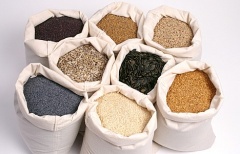| Infobox on Oil Seeds
|
| Example of Oil Seeds
|
|
| Facts
|
| Origin
|
-
|
| Stowage factor (in m3/t)
|
-
|
| Humidity / moisture
|
-
|
| Ventilation
|
-
|
| Risk factors
|
See text
|
Oil Seeds
Description / Application
A seed oil is a vegetable oil that is obtained from the seed (endosperm) of some plant, rather than the fruit (pericarp).
Most vegetable oils are seed oils. Some common examples are Sunflower Oil, canola oil, and sesame oil.
Some important vegetable oils are not seed oils. Some examples are olive oil and peanut oil.
A vegetable oil is a triglyceride extracted from a plant. Such oils have been part of human culture for millennia. The term "vegetable oil" can be narrowly defined as referring only to substances that are liquid at room temperature, or broadly defined without regard to a substance's state of matter at a given temperature. For this reason, vegetable oils that are solid at room temperature are sometimes called vegetable fats. Vegetable oils are composed of triglycerides, as contrasted with waxes which lack glycerin in their structure. Although many plant parts may yield oil, in commercial practice, oil is extracted primarily from seeds.
On food packaging, the term "vegetable oil" is often used in ingredients lists instead of specifying the exact plant being used.
Production
To produce vegetable oils, the oil first needs to be removed from the oil-bearing plant components, typically seeds. This can be done via mechanical extraction using an oil mill or chemical extraction using a solvent. The extracted oil can then be purified and, if required, refined or chemically altered.
Mechanical extraction
Oils can also be removed via mechanical extraction, termed "crushing" or "pressing." This method is typically used to produce the more traditional oils (e.g., olive, coconut etc.). There are several different types of mechanical extraction. Expeller-pressing extraction is common, though the screw press, ram press, and Ghani (powered mortar and pestle) are also used. Oil seed presses are commonly used in developing countries, among people for whom other extraction methods would be prohibitively expensive; the Ghani is primarily used in India. The amount of oil extracted using these methods varies widely, as shown in the following table for extracting mowrah butter in India:
| Method
|
Percentage extracted
|
| Ghani
|
20-30%
|
| Expellers
|
34-37%
|
| Solvent
|
40-43%
|
| Canola
|
Canola oil
|












